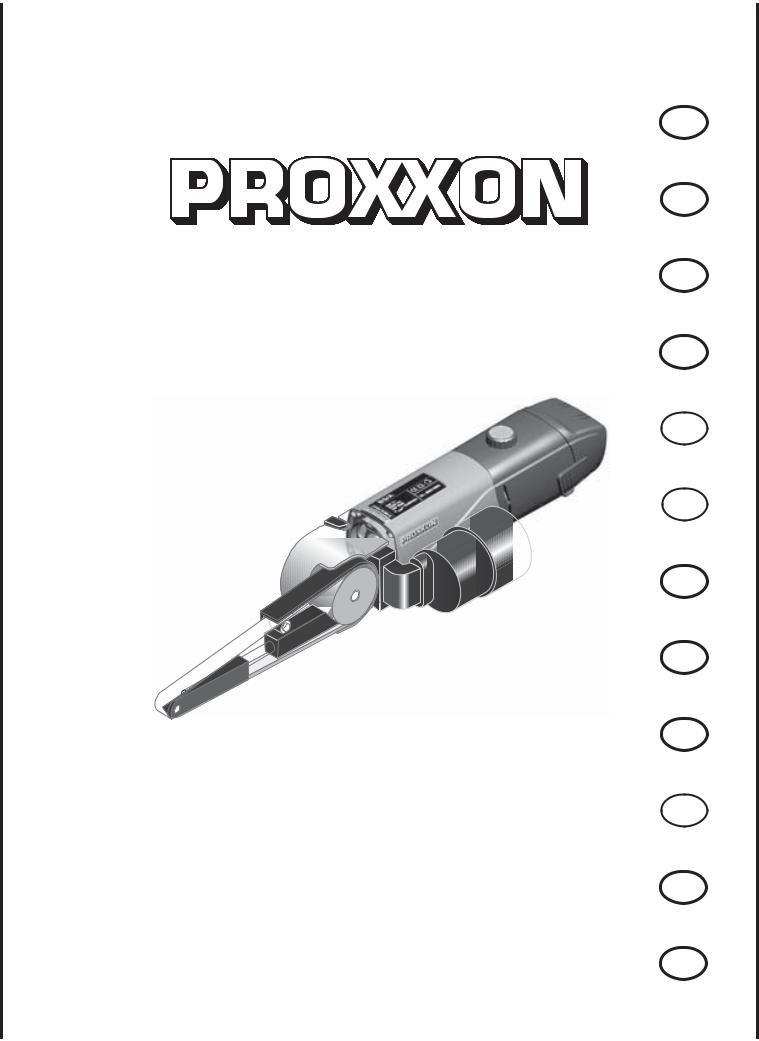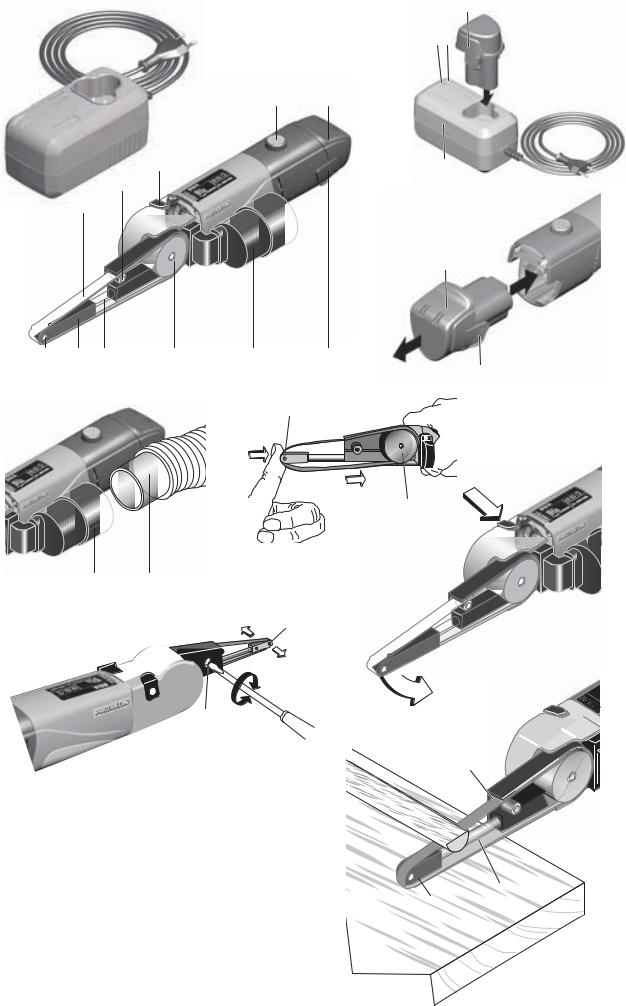Proxxon BS/A User guide [ml]

DE
GB
FR
Bandschleifer BS/A
IT
ES
NL
DK
SE
CZ
TR
PL
Manual
RUS

Deutsch |
DE |
4 |
Beim Lesen der Gebrauchsanleitung |
|
|
Bildseiten herausklappen. |
|
|
English |
GB |
10 |
Fold out the picture pages |
|
|
when reading the user intructions. |
|
|
Français |
FR |
16 |
Lorsque vous lisez le manuel d’utilisation, |
|
|
veuillez déplier les pages d’illustration. |
|
|
Italiano |
IT |
22 |
Per leggere le istruzioni per l’uso |
|
|
aprire le pagine ripiegate contenenti le figure. |
|
|
Español |
ES |
28 |
Al consultar el manuel de instrucciones |
|
|
abrir la hoja plegable. |
|
|
Nederlands |
NL |
34 |
Bij het lezen van de gebruiksaanwijzing |
|
|
pagina´s met afbeeldingen uitklappen. |
|
|
Dansk |
DK |
40 |
Når brugsanvisningen læses, |
|
|
skal billedsiderne klappes ud. |
|
|
Svenska |
SE |
46 |
Vid läsning av bruksanvisningen, |
|
|
fall ut bildsidoma. |
|
|
Èesky |
CZ |
52 |
Pří čtení návodu k obsluze rozložit stránky s obrázky.
Türkçe
Kullanma Talimatının okunması esnasında resim sayfalarını dişarı çıkartın.
Polski
Przy czytaniu instrukcji obslugi otworzyç strony ze zdj´ciami.
PyccÍËÌ
УЛ ЪХИРЛЛ УЦНСЕСЗФХЕГ ТС КНФТОЦГХГЩЛЛ ТУСФЯДГ СХНУЮЕГХЯ ФХУГРЛЩЮ Ф УЛФЦРНГПЛ.
TR 58
PL 63
RUS 68
- 2 -

|
|
1 |
Fig. 1 |
4 3 |
Fig. 2 |
|
||
1 |
2 |
|
11 |
2 |
10
 9 12
9 12
Fig. 3
1
8 |
6 |
7 |
5 |
4 |
3 |
2
1 |
Fig. 5 |
Fig. 4
2
1 |
2 |
Fig. 7 |
|
|
1
Fig. 6
2
2
Fig. 8
 3
3
1
B
2 

- 3 -

DE
Originalbetriebsanleitung
PROXXON - BS/A
Sehr geehrte Kundin, sehr geehrter Kunde!
Die Benutzung dieser Anleitung
•erleichtert es, das Gerät kennen zu lernen.
•vermeidet Störungen durch unsachgemäße Bedienung und
•erhöht die Lebensdauer Ihres Gerätes. Halten Sie diese Anleitung immer griffbereit.
Bedienen Sie dieses Gerät nur mit genauer Kenntnis und unter Beachtung der Anleitung.
PROXXON haftet nicht für die sichere Funktion des Gerätes bei:
•Handhabung, die nicht der üblichen Benutzung entspricht,
•anderen Einsatzzwecken, die nicht in der Anleitung genannt sind,
•Missachtung der Sicherheitsvorschriften.
Sie haben keine Gewährleistungsansprüche bei:
•Bedienungsfehlern,
•mangelnder Wartung.
Beachten Sie zu Ihrer Sicherheit bitte unbedingt die Sicherheitsvorschriften.
Nur Original PROXXON-Ersatzteile verwenden.
Weiterentwicklungen im Sinne des technischen Fortschrittes behalten wir uns vor.
Wir wünschen Ihnen viel Erfolg mit dem Gerät.
Warnung:
Lesen Sie alle Sicherheitshinweise und Anweisungen. Versäumnisse bei der Einhaltung der Sicherheitshinweise und Anweisungen können
elektrischen Schlag, Brand und/oder schwere Verletzungen verursachen zur Folge haben.
Bewahren Sie alle Sicherheitshinweise und Anweisungen für die Zukunft auf.
- 4 -
Warnung:
Tragen Sie immer eine Schutzbrille
Nur zum Gebrauch in trockenen Räumen
Ladegerät LG/A
Schutzklasse II-Gerät
Elektrowerkzeug, Ladegerät oder Akku nicht über den Hausmüll entsorgen!
Gehörschutz tragen!
Beschreibung der Maschine
Der PROXXON Bandschleifer BS/A ist ein leichtes, kompaktes und handliches Gerät, dass sich ideal für Modell-, Werkzeugund Formenbau, aber auch bei der Reparatur von Kraftfahrzeugen einsetzen lässt.
Anwendungsbeispiele sind
•das Einschleifen von Nuten
•das Korrigieren besonders unzugänglicher Stellen
•das Nachschleifen von besonders komplex gestalteten Formen
•das Ausschleifen kleiner Öffnungen und Durchbrüche, egal in welchen Werkstoffen, also auch hochfesten Stählen
•das Begradigen, Blankschleifen und Hochglanzpolieren von Flächen: der ziehende Schliff hinterlässt keine störenden Schleifspuren,
•das Schleifen von Sägeblättern, Beiteln und sogar Drehstählen,
•Feinschleifen von Oberflächen
•Entfernen von Farben und Lacken
•Brechen von Kanten
•das Entgraten und Anfasen von Präzisionsteilen, usw.
Die Edelkorundschleifbänder erlauben die Bearbeitung von Metall, Kunststoff und Holz. Ein extrem robustes Getriebe überträgt die Motorkraft auf die Antriebsrolle für das Schleifband am Getriebekopf.
Dieses läuft auf dem Schleifkopf, wo es mit einer Spannrolle am vorderen Ende umgelenkt wird.
Der Schleifkopf kann geschwenkt werden, so dass Arbeiten auch an unzugänglichen Stellen möglich ist.

1 Legende (Fig. 1)
1.Drehzahlregelknopf mit Ein-Aus-Schalter
2.Akku
3.Akkuentriegelungstaste
4.Adapter für Staubabsaugung
5.Antriebsrolle
6.Schleifkopf zur Bandführung
7.Spannstab
8.Spannrolle
9.Schleifband
10.Justierschraube für Bandlauf
11.Rastknopf
12.Akkuladegerät
2 Technische Daten
Abmessungen, Gewicht: |
|
Länge: |
ca. 330 mm |
Gewicht: |
ca. 650 g |
Schleifbandlänge: |
330 x 10 mm |
Kopf schwenkbar um 60° |
|
Motor: |
|
Spannung: |
10,8 V |
Bandgeschwindigkeit: |
200 bis 700 m/min |
Geräuschentwicklung: |
LPA: 90 dB(A) |
LWA: 103 dB(A) |
|
Allgemeine |
|
Meßunsicherheit: |
K=3dB |
Vibration am Griff: |
) 2,5 m/sec2 |
Ladegerät: |
|
Netzspannung: |
100-240 V~50/60Hz |
Ausgangsspannung: |
12,6 V |
Ladestrom: |
1 A |
Akku:
Wiederaufladbare Li-Ionen Batterie Nominal-/Ladespannung: 10,8V/12,6V Energie/Kapazität: 28,19Wh/2,61Ah 3 INR 19/66
Bitte beachten Sie, dass insbesondere die Schallund Vibrationsmessungen mit ProxxonEinsatzwerkzeugen durchgeführt worden sind.
Wir können bei der Verwendung von Fremdfabrikaten nicht für die Einhaltung der hier getroffenen Aussagen garantieren!
3 Lieferumfang
BS/A (29810)
1 St. Bandschleifer BS/A
1St. Anschlussadapter
1St. Gummistutzen
1St. Aufbewahrungsbox
1St. Ladegerät
1St. Akku
1St. Betriebsanleitung
1St. Sicherheitshinweise 2 St. Schleifband K 80
2 St. Schleifband K 180
BS/A (29812)
1 St. Bandschleifer BS/A
1St. Anschlussadapter
1St. Gummistutzen
1St. Betriebsanleitung
1St. Sicherheitshinweise 2 St. Schleifband K 80
2 St. Schleifband K 180
4 Inbetriebnahme und Bedienung
Laden des Akkus (Fig.2 und 3)
Achtung:
Lesen Sie vor der Inbetriebnahme die Warnhinweise und Aufschriften, die an dem Ladegerät und dem Akku angebracht sind!
•Akku nicht zerlegen oder das Gehäuse zerbrechen! Elektrolyt könnte austreten und Verletzungen verursachen! Sollte Elektrolyt in Ihre Augen gelangen, waschen Sie diese mit sauberem Wasser aus und begeben Sie sich unverzüglich in ärztliche Behandlung!
•Akku vor Überhitzung schützen! Defekte können die Folge sein.
•Akku niemals kurzschließen! Starke Ströme können eine Überhitzung des Akkus bewirken.
-5 -
Verbrennungen oder ein Defekt sind die möglichen Folgen. Stellen Sie bei der Lagerung des Akkus sicher, dass die elektrischen Kontakte keine leitende Verbindung bekommen können.
•Akku niemals in offenes Feuer geben! Der Akku kann explodieren.
•Setzen Sie den Akku niemals Flüssigkeiten aus!
Achtung:
Bitte beachten Sie, dass Ihr Proxxon-Elektro- werkzeug nur mit den passenden ProxxonAkkus betrieben werden darf und dass mit dem Ladegerät ausschließlich diese Akkus geladen werden dürfen.
Ferner darf auch kein anderes Ladegerät zum Laden der Proxxon-Akkus verwendet werden: Die jeweiligen Proxxon-Komponenten sind optimal aufeinander abgestimmt.
Bitte beachten Sie: Gerät, Akku und Ladegerät sind auch separat im Handel erhältlich!
Im Auslieferungzustand ist der Akku teilgeladen und muss vor der Inbetriebnahme des Gerätes voll aufgeladen werden. Dazu gehen Sie wie folgt vor:
1.Stecker des Ladegerätes einstecken.
2.Akku 1 in das Ladegerät 2 einfügen wie in Fig. 2 gezeigt.
3.Die gelbe Leuchtdiode 3 signalisiert den Ladevorgang. Ist dieser abgeschlossen, leuchtet die grüne Leuchtdiode 4 auf.
4.Vollgeladenen Akku aus dem Ladegerät entnehmen.
5.Akku 1 wie in Fig. 3 gezeigt in die Gehäuseöffnung des Gerätes einstecken.
Um den Akku beim Arbeiten vor schädlicher Tiefentladung zu schützen, wird der Ladezustand permanent elektronisch überwacht und das Gerät vor dem Erreichen des kritischen Entladungszustands abgeschaltet. Nun muss der Akku wieder aufgeladen werden. Versuchen Sie nicht, das Gerät wieder mit entladenem Akku in Betrieb zu nehmen!
6.Zum Aufladen die Entriegelungstasten 2 drücken, Akku nach hinten herausziehen und die Schritte 1-5 ausführen.
- 6 -
Der Ladevorgang kann jederzeit unterbrochen und wieder neu aufgenommen werden, ohne dass der Akku Schaden nimmt.
Achtung:
Wenn sich die Betriebszeiten nach dem Ladevorgang drastisch verkürzen, deutet das darauf hin, dass der Akku erneuert erden muss!
Falls nach dem Einstecken des Akkus in die dafür vorgesehene Öffnung die gelbe Leuchtdiode nicht permanent leuchtet, sondern blinkt, ist die Ursache möglicherweise eine zu hohe Temperatur, ein Defekt oder die Tiefentladung des Akkus.
•Ist der Akku zu heiß, wird nach dem Abkühlen der Ladevorgang automatisch gestartet.
•Ist der Akku dagegen normal temperiert, aber tiefentladen, wird vom Ladegerät geprüft, ob er noch Strom aufnimmt oder bereits defekt ist.
•Wenn der Akku wiederherstellbar ist, leuchtet die gelbe Leuchtdiode nach einiger Zeit kontinuierlich und signalisiert den erfolgreichen Ladevorgang.
•Blinkt die gelbe Leuchtdiode, ist der Akku defekt und muss entsorgt werden, siehe dazu auch „Hinweis zur Entsorgung innerhalb der EU“ weiter unten in dieser Anleitung.
Allgemeines zum Umgang mit dem Gerät:
Achtung!
Sorgen Sie für eine sichere Fixierung des Werkstücks! Lose Werkstücke sollten in einer geeigneten Vorrichtung eingespannt werden. Das Umherfliegen des Werkstücks wird so unterbunden
Gefahr!
Bitte gegebenenfalls eine Staubmaske tragen! Einige Hölzer oder auch Lackrückstände o. ä. können beim Arbeiten gesundheitsschädliche Stäube erzeugen. Wenn Sie sich der Unbedenklichkeit ihres Schleifguts nicht ganz sicher sind, tragen Sie bitte eine Staubschutzmaske! Sorgen Sie in jedem Fall beim Arbeiten für eine gute Belüftung des Arbeitsplatzes und arbeiten

Sie bei Bedarf mit einer Absaugung mittels eines Staubsaugers!
Achtung:
Vor Montage, Einstellung (Außer der Einstellung des Bandlaufs), Instandhaltungsmaßnahmen oder Instandsetzung muss der Akku aus dem Gerät entfernen!
Staubsauger anschließen (Fig. 4)
Wir empfehlen, immer mit der Staubabsaugung zu arbeiten. Ideal für diesen Einsatz ist unser „Compact Werkstattsauger CW-matic“ mit automatischer Abschaltung.
1.Anschlussdapter 1 auf Stutzen am Gerät stecken
2.Gummistutzen 2 aufstecken und Staubsaugerschlauch einführen. Durch das flexible Gummimaterial lassen sich auch unterschiedliche Durchmesser verwenden.
Schleifband wechseln (Fig. 5)
1.Axial auf die Spannrolle 1 drücken und Schleifband von der Antriebsrolle 2 abnehmen.
2.Neues Schleifband zuerst um die Spannrolle 1 legen. Dann Spannrolle nach hinten drücken und Band über die Antriebsrolle 2 legen.
Schleifrolle justieren (Fig. 6)
Das Schleifband muss mittig auf der Spannrolle laufen. Ist dies nicht der Fall, muss es nachjustiert werden.
Achtung Verletzungsgefahr!
Bei dieser Einstellung muss das Gerät laufen. Bitte gehen Sie daher bei der Einstellung des Bandlaufs mit der größtmöglichen Vorsicht vor!
Das laufende Band birgt ein potentielles Gefahrenpotential und kann bei unaufmerksamer Handhabung des Geräts Verletzungen verursachen!
1.Gerät durch Drehen des Knopfes 1 einschalten und kleine Bandgeschwindigkeit einstellen.
2.Justierschraube 2 nach links bzw. rechts drehen bis das Band auf der Spannrolle 1 zentrisch läuft.
Schleifkopf verstellen (Fig. 7)
1.Rastknopf 1 eindrücken und dabei den Schleifkopf 2 auf den gewünschten Winkel einstellen.
2.Rastknopf loslassen. Der Schleifkopf rastet ein.
Arbeiten mit dem Gerät (Fig. 8)
1.Gerät mit Drehzahlregelknopf (1, Fig. 1) einschalten und die der Arbeit entsprechende Drehzahl einstellen.
2.Die Schleiffläche 2 eignet sich besonders zum Bearbeiten von planen Flächen.
3.Mit der Schleiffläche 1 bearbeitet man am besten Rundungen.
4.Die Stirnseite 3 ist geeignet für Arbeiten an engen Öffnungen und Vertiefungen.
Hinweis:
Nicht ein zu hoher Anpressdruck, sondern die richtige und gleichmäßige Bandgeschwindigkeit bringt hohe Schleifleistung.
5 Wartung, Reinigung und Pflege
Achtung:
Vor jeglicher Montage, Einstellung, Instandhaltungsmaßnahme oder Instandsetzung Akku aus dem Gerät entfernen!
Hinweis:
Jedes Gerät wird beim Arbeiten mit Holz durch Staub verunreinigt. Pflege ist daher unerlässlich. Für eine lange Lebensdauer sollten Sie das Gerät allerdings nach jedem Gebrauch mit einem weichen Lappen oder Pinsel reinigen.
Dabei darf milde Seife oder eine anderes geeignetes Reinigungsmittel benutzt werden. Lösungsmitteloder alkoholhaltige Reinigungsmittel (z. B. Benzin, Reinigungsalkohole etc.) sind zu vermeiden, da diese die Kunststoffgehäuseschalen angreifen könnten.
Halten Sie die Öffnungen, die für die Kühlung des Motors notwendig sind, immer frei von Staub und Schmutz.
- 7 -

Service-Hinweis
Bitte beachten Sie: Die Netzzuleitung für das Ladegerät darf nur von unserer Proxxon-Servi- ceabteilung oder einer qualifizierten Fachkraft ersetzt werden!
6 Zubehör
Für nähergehende Informationen zum Zubehör fordern Sie bitte unseren Geräte-Katalog unter der im Garantiehinweis auf der letzten Seite angegebenen Adresse an.
Bitte beachten Sie generell:
Proxxon-Einsatzwerkzeuge sind zum Arbeiten mit unseren Maschinen konzipiert und damit optimal für die Verwendung mit diesen geeignet.
Wir übernehmen bei der Verwendung von Einsatzwerkzeugen von Fremdfabrikaten keinerlei Gewährleistung für die sichere und ordnungsgemäße Funktion unserer Geräte!
7 Entsorgung:
Bitte entsorgen Sie das Gerät nicht über den Hausmüll! Das Gerät enthält Wertstoffe, die recycelt werden können. Bei Fragen dazu wenden Sie sich bitte an Ihre lokalen Entsorgungsunternehmen oder andere entsprechende kommunale Einrichtungen.
Hinweis zur Entsorgung innerhalb der EU:
Bitte beachten Sie, dass nach der EU-Richtlinie 2012/19/EU und der EU-Richtlinie 2006/66/ EG defekte oder verbrauchte Akkumulatoren und nicht mehr gebrauchsfähige Elektrogeräte getrennt vom Hausmüll entsorgt werden sollen und einer umweltgerechten Wiederverwendung zugeführt werden müssen!
8 CE-Konformitätserklärung
Name und Anschrift des Herstellers: PROXXON S.A.
6-10, Härebierg
L-6868 Wecker
Produktbezeichnung: |
BS/A |
Artikel Nr.: |
29810/29812 |
Wir erklären in alleiniger Verantwortung, dass dieses Produkt mit den folgenden Richtlinien und normativen Dokumenten übereinstimmt:
EU-EMV-Richtlinie 2014/30/EU
DIN EN 55014-1 / 05.2012
DIN EN 55014-2 / 11.2014
DIN EN 61000-3-2 / 03.2015
DIN EN 61000-3-3 / 03.2014
EU-Maschinenrichtlinie 2006/42/EG
DIN EN 60745-1 / 01.2010 DIN EN 60745-2-4 / 11.2012
Datum: 24.04.2016
Dipl.-Ing. Jörg Wagner
PROXXON S.A.
Geschäftsbereich Gerätesicherheit
Der CE-Dokumentationsbevollmächtigte ist identisch mit dem Unterzeichner.
- 8 -

GB
Original operating instructions PROXXON - BS/A
Dear customer!
Always keep these operating instructions and the enclosed safety guidelines within reach.
Only use this device with exact knowledge of it and comply with the instructions and safety guidelines!
This is necessary to ensure safe operation and, secondly, it facilitates familiarisation with the device and its functions.
Proxxon assumes no liability for the safe function of the device in the case of:
•handling that does not comply with normal intended use,
•use for other purposes not mentioned in the manual,
•incorrectly executed repairs,
•failure to heed safety instructions,
•external effects for which the manufacturer is not responsible.
We recommend using PROXXON original spare parts for all repair and maintenance work. Repairs should only be performed by qualified skilled personnel!
Please note: All information contained in these operating instructions - especially the technical data - corresponds to the status at the time of printing.
We reserve the right to make further developments in the interest of technical progress. We wish you every success with the device.
Warning!
Read through all safety guidelines and instructions! Failure to adhere to safety guidelines and instructions
can result in electrical shock, fire and/or serious injuries as consequence.
Store all safety guidelines and instructions for the future.
Warning
Always wear protective goggles
Only for use in dry rooms
Charger LG/A
Protection class II device
Do not dispose of the power tool,
charger or battery with household rubbish!
Wear hearing protection!
Description of the machine
The PROXXON BS/A belt sander is a light, compact and handy device ideal for model, tool and mould construction but which can also be used for the repair of motor vehicles.
Application examples are
•grinding in of grooves
•correcting of especially inaccessible areas
•re-sanding of especially complexly formed shapes
•grinding out of small openings and breakthroughs, regardless of the materials, and also high-strength steels
•straightening, smooth sanding and high-shine polishing of surfaces: the pulled grinding does not leave annoying grinding marks
•grinding of saw blades, chisels and even cutting tools
•precision polishing of surfaces
•removal of paints and varnishes
•rounding off of edges
•deburring and chamfering of precision parts, etc.
The high-grade corundum sanding belts enable machining of metal, plastic and wood.
An extremely robust gearbox transfers the motive force to the driving roller for the sanding belt at the gear head.
This runs on the grinding head where it is diverted by a tightening roller at the front end.
The grinding head can be swivelled to enable work even at inaccessible areas.
- 9 -

1 Key (Fig. 1)
1.Rotational speed regulating knob with On/Off switch
2.Battery
3.Battery release button
4.Adapter for dust extraction
5.Driving roller
6.Grinding head to belt guide
7.Stretcher
8.Tightening roller
9.Grinding belt
10.Adjusting screw for belt running
11.Locking button
12.Charger
2 Technical data
Dimensions, weight: |
|
Length: |
approx. 330 mm |
Weight: |
approx. 650 g |
Grinding belt length: |
330 x 10 mm |
Head can be swivelled by 60° |
|
Motor: |
|
Voltage: |
10.8 V |
Band speed: |
200 to 700 m/min |
Noise generation: |
LPA: 90 dB(A) |
LWA: 103 dB(A)
General measuring uncertainty: K=3dB
Grip vibration: |
) 2.5 m/sec2 |
Charger: |
|
Mains voltage: |
100-240 V~50/60Hz |
Output voltage: |
12.6 V |
Charging current: |
1 A |
Battery:
Rechargeable lithium-ion battery Nominal/charging voltage: 10.8V/12.6V Energy/Capacity: 28.19Wh/2.61Ah 3 INR 19/66
Please note that the sound and vibration measurements in particular have been performed with Proxxon bits and cutters. When using third-party brands we cannot guarantee com-
- 10 -
pliance with the statements given here!
3 Scope of delivery
BS/A (29810)
1 pc. Belt sander BS/A
1 pc. Connection adapter
1 pc. Rubber connecting piece
1 pc. Storage case
1 pc. Charger
1 pc. Battery
1 pc. Operating instructions
1 pc. Safety guidelines
2 pcs. Fan sander K 80
2 pcs. Fan sander K 180
BS/A (29812)
1 pc. Belt sander BS/A
1 pc. Connection adapter
1 pc. Rubber connecting piece
1 pc. Operating instructions
1 pc. Safety guidelines
2 pcs. Fan sander K 80
2 pcs. Fan sander K 180
4 Commissioning and operation
Charging the battery (Fig. 2 and 3)
Caution:
Before starting up, read the warning instructions and the labels attached to the charger and the battery!
•Do not disassemble the battery or break the housing! Electrolytes could leak out and cause injuries! If electrolyte gets into your eyes, rinse them with clean water and seek medical attention immediately!
•Protect battery from overheating! Defects could be the result.
•Never short-circuit the battery! Strong currents could overheat the battery. Burns or a defect could be the possible result. When storing the batteries, ensure that the electric contacts cannot establish a conductive connection.
•Do not put the battery in open fire!
The battery can explode.
• Never subject the battery to liquids!
Caution:
Please note that your Proxxon power tool may only be operated with the appropriate Proxxon battery and that the charger is to be used exclusively for the charging of these batteries.
Furthermore, no other charger may be used to charge the Proxxon battery: The respective Proxxon components are optimally coordinated.
Please note: The device, battery and charge are also separately available at retailers!
When delivered, the battery is partially charged and must be charged completely before commissioning the device. To do so, proceed as follows:
1.Insert the plug of the charger.
2.Insert battery 1 in the charger 2 as shown in Fig. 2.
3.The yellow light-emitting diode 3 signals the charging process. When completed, the green light-emitting diode 4 lights up.
4.Remove the completely charged battery from the charger.
5.Insert battery 1 as shown in Fig. 3 in the housing opening of the device until it engages.
To protect the battery from harmful total discharge while in operation, the charge status is permanently monitored electronically and the device will switch off before it reaches the critical discharge condition. The battery will now need to be recharged. Do not attempt to put the device back into operation with a discharged battery!
6.To charge, press the release buttons 2, pull out the battery to the rear and carry out steps 1-5.
The charging process can be interrupted at any time and continued without damage to the battery.
Caution:
Drastically reduced operating times after the charging process indicates that the battery needs to be replaced!
If after inserting the battery into its designated opening the light-emitting diode flashes instead of glowing yellow continuously, the cause may be a too high temperature, a defect, or the total discharge of the battery.
•If the battery is too hot, the charging process will start automatically after it cools down.
•If, on the other hand, the battery has a nor mal temperature but is totally discharged, the charger will check if it still draws power or it if is already defective.
•If the battery can be recovered, the yellow light-emitting diode will glow continuously after some time, signalling the successful charging process.
•If the yellow light-emitting diode flashes, the battery is defective and needs to be disposed of; see also "Note on disposal within the EU" later on in these instructions.
General handling of the device:
Caution!
Ensure the work piece is fixed securely! Loose work pieces should be clamped in a suitable fixture. This prevents the work pieces from flying about
Danger!
Please wear a dust mask as necessary! Some types of wood or even varnish residues (or similar) can generate harmful dusts while working. If you are unsure of the harmlessness of your material to be ground, please wear a dust protection mask! Ensure the work place is well ventilated in any case and work with a vacuum cleaner for dust extraction as necessary!
Caution:
The battery must be removed from the device before assembly, adjustment (except the belt running adjustment), maintenance measures or repair!
- 11 -

Connect the vacuum cleaner (Fig. 4)
We recommend to always work with the dust extraction. Our "Compact Workshop Vacuum Cleaner CW-matic" with automatic cut-off is ideal for this use.
1.Put connection adapter 1 on the connecting piece of the device
2.Put on the rubber connecting piece 2 and insert the vacuum cleaner hose. The flexible rubber material makes it possible to use different diameters.
Changing the grinding belt (Fig. 5)
1.Press the tightening roller 1 axially and remove grinding belt from driving roller 2.
2.Place the new grinding belt first over the tightening roller 1. Then press the tightening roller towards the back and place the belt over the driving roller 2.
Adjusting the grinding roller (Fig. 6)
The grinding belt must run centrally on the tightening roller. If not, it needs to be readjusted.
Caution, risk of injury!
The device must run with this setting. Please proceed with the greatest possible caution for the belt running adjustment!
The running belt represents a potential hazard and can cause injuries if the device is handled carelessly!
1.Switch on the device by turning the button 1 and setting the small belt speed.
2.Turn the adjusting screw 2 to the left or right until the belt runs centrally on the tightening roller 1.
Adjusting the grinding head (Fig. 7)
1.Press in locking button 1 whilst adjusting the grinding head 2 to the desired angle.
2.Release the locking button. The grinding head engages.
Working with the device (Fig. 8)
1.Activate the device with the rotational speed regulating knob (1, Fig. 1) and set the right
speed for the work.
2.The grinding surface 2 is particularly suited for machining flat surfaces.
3.Grinding surface 1 is best used to grind curves.
4.Face side 3 is suited for work on tight openings and recesses.
Note:
Not excessive contact pressure is what achieves a high grinding performance but rather the correct and uniform speed.
5 Maintenance, cleaning and care
Caution:
Remove the battery from device before any assembly, adjustment, maintenance measure or repair!
Note:
Every device is dirtied by dust when working with wood. Cleaning is therefore essential. To ensure a long service life, however, the machine should be cleaned with a soft cloth or brush after each use.
Mild soap or other suitable cleaning agent may be used in this context. Solvents or cleaning agents containing alcohol (e.g. petrol, cleaning alcohols etc.) should be avoided, since these can attack plastic casings.
Always keep the apertures required for cooling the motor free of dust and dirt.
Service note
Please note: The mains power input for the charger may only be replaced by our Proxxon Service Department or a qualified specialist!
6 Accessories
For more detailed information on accessories, please request our device catalogue from the address specified on the last page in the warranty information.
- 12 -

Please note in general:
Proxxon bits and cutters have been designed to work with our machines, which makes them optimal for their use.
We will not assume any liability whatsoever for the safe and proper function of our devices when using third-party bits and cutters!
7 Disposal:
Please do not dispose of this machine in household waste! The device contains valuable materials which can be recycled. If you have questions concerning this topic, please contact your municipal disposal company or other appropriate municipal institutions.
Note on disposal within the EU:
Please note that in accordance with the EU directive 2012/19/EU and the EU directive 2006/66/EC, defective or consumed accumulators and no longer operational electrical devices must be disposed of separately from household waste and must be sent for reuse in an environmentally responsible manner!
8 CE Declaration of conformity
Name and address of the manufacturer: PROXXON S.A.
6-10, Härebierg
L-6868 Wecker
Product designation: |
BS/A |
Article No.: |
29810/29812 |
On our sole responsibility, we declare that this product conforms to the following directives and normative documents:
EU EMC Directive 2016/30/EU
DIN EN 55014-1 / 05.2012
DIN EN 55014-2 / 01.2016
DIN EN 61000-3-2 / 03.2015
DIN EN 61000-3-3 / 03.2014
EU Machinery Directive 2006/42/EC
DIN EN 60745-1 / 01.2010 DIN EN 60745-2-4 / 11.2012
Date: 24.04.2016
Dipl.-Ing. Jörg Wagner
PROXXON S.A.
Appliance Safety Division
The CE document authorized agent is identical with the signatory.
- 13 -

FR
Manuel d’utilisation original
PROXXON - BS/A
Veuillez toujours conserver à portée de main cette notice d’utilisation et les prescriptions de sécurité jointes.
Utilisez l’appareil uniquement avec des connaissances précises, conformément à ce manuel ainsi qu’aux prescriptions de sécurité !
Cela est nécessaire d’une part pour un fonctionnement sans danger de l’appareil et d’autre part, pour vous faciliter l’apprentissage de l’appareil et de ses fonctions.
Proxxon décline toute responsabilité en cas :
•d’utilisation non conforme à l’utilisation conventionnelle,
•d’utilisation autre que celles nommées dans ce guide,
•de réparations effectuées de manière non conforme,
•de non-respect des prescriptions de sécurité,
•d’événements extérieurs qui échappent à la responsabilité du fabricant.
Nous recommandons, pour tous les travaux de rsponsabilité du fabricant.reil et d’autre part, pour vous faciliter l’apprentis
Faites effectuer les réparations uniquement par un personnel qualifié à cet effet !
Attentionnel qualifié à cet effet !iquement par nsabilité du fabricant.reil et d’autre part, pour vous faciliter l’apprentissage de l’appareil et de ses fonction presse de ce manuel.
Tous droits de modification survenant dans le cadre du progrès technique réservés. Nous vous souhaitons le plus grand succès avec votre appareil.
- 14 -
Attention !
Lire toutes les consignes de sécurité et les instructions. Tout manquement au respect des consignes
de sécurité et des instructions peut être cause d’électrocution, d’incendie et/ou de graves blessures.
Conserver toutes les consignes de sécurité et les instructions pour l’avenir.
MISE EN GARDE
Toujours porter des lunettes de protection
Utiliser uniquement dans des locaux secs.
Chargeur LG/A
Appareil de classe de protection II
Ne pas éliminer l’outil électrique, le chargeur ou l’accumulateur avec les déchets domestiques !
Porter des protège-oreilles !
Description de la machine
La ponceuse à bande PROXXON BS/A est un appareil léger, compact et maniable parfait non seulement pour le modélisme et la fabrication d’outils et de moules, mais aussi pour la réparation de véhicules automobiles.
Voici des exemples d’application :
•le polissage de rainures
•la correction d’endroits difficilement accessibles
•la rectification de moules aux formes particulièrement complexes
•le rodage de petits trous et perforations, quel que soit le matériau – donc aussi dans les aciers à résistance élevée
•la rectification, le ponçage et le polissage spéculaire de surfaces : le poli ne laisse pas de traces de frottement gênantes
•le meulage de lames de scie, bédanes et même burin acier
•l’affûtage-finition de surfaces
•l’élimination de couleurs et laques
•la cassure de bords

•l’ébavurage et le biseautage de pièces de précision, etc.
Les bandes de ponçage en corindon précieux permettent l’usinage du métal, du plastique et du bois.
Une transmission très solide transmet la puissance motrice au rouleau d’entraînement de la bande de ponçage sur la tête de transmission. Celle-ci passe par la tête d’affûtage où elle est reroutée vers le bout avant par un galet tendeur. La tête d’affûtage peut être pivotée de manière qu’il est possible de travailler même à des endroits inaccessibles.
1 Légende (Fig. 1)
1.Bouton de réglage de la vitesse avec interrupteur de marche/arrêt
2.Accumulateur
3.Touche de déverrouillage de l’accumulateur
4.Adaptateur pour aspiration de poussières
5.Rouleau d’entraînement
6.Tête d’affûtage pour guidage de bande
7.Barre tendeuse
8.Galet tendeur
9.Bande de ponçage
10.Vis d’ajustage pour le défilement
11.Bouton cranté
12.Chargeur d’accumulateur
2 Caractéristiques techniques
Dimensions, poids : |
|
Longueur : |
env. 330 mm |
Poids : |
env. 650 g |
Longueur de bande |
|
de ponçage : |
330 x 10 mm |
Tête pivotable de 60° |
|
Moteur : |
|
Tension : |
10,8 V |
Vitesse de bande : |
200 à 700 m/min |
Niveau de bruit : |
LPA : 90 dB(A) |
LWA : |
103 dB(A) |
Insécurité de mesure générale : K=3dB Vibrations sur la poignée : ) 2,5 m/sec2
Chargeur : |
|
Tension réseau : |
100-240 V~50/60Hz |
Tension de sortie : |
12,6 V |
Courant de charge : |
1 A |
Accumulateur :
Batterie à lithium-ion rechargeable Tension de charge/
nominale : 10,8V/12,6V Énergie/capacité : 28,19Wh/2,61Ah
3 INR 19/66
À noter que les mesures acoustiques et vibratoires, en particulier, ont été effectuées avec des outils interchangeables Proxxon. L’utilisation de produits d’autres fabricants ne permet pas de garantir le respect de ce qui est affirmé ici !
3 Fourniture
BS/A (29810)
1 p.ce ponceuse à bande BS/A
1 p.ce adaptateur de raccordement
1 p.ce manchon de caoutchouc
1 p.ce boîte de rangement
1 p.ce chargeur
1 p.ce accumulateur
1 p.ce manuel d’utilisation
1 p.ce consignes de sécurité
2 p.ce bande de ponçage K 80
2 p.ce bande de ponçage K 180
BS/A (29812)
1 p.ce ponceuse à bande BS/A
1 p.ce adaptateur de raccordement
1 p.ce manchon de caoutchouc
1 p.ce manuel d’utilisation
1 p.ce consignes de sécurité
2 p.ce bande de ponçage K 80
2 p.ce bande de ponçage K 180
- 15 -

4 Mise en service et commande
Chargement de l’accumulateur (Fig. 2 et 3)
Attention :
Avant la mise en service, lire les avertissements et les étiquettes qui se trouvent sur le chargeur et l’accumulateur !
•Ne pas démonter l’accumulateur ou ne pas casser le boîtier ! Il pourrait s’ensuivre une fuite d’électrolyte causant des blessures ! Si de l’électrolyte éclabousse dans les yeux, les laver à l’eau propre et consulter immédi atement un médecin !
•Protéger l’accumulateur de la surchauffe ! Cela pourrait entraîner des défauts.
•Ne jamais court-circuiter l’accumulateur ! Les courants forts peuvent entraîner une surchauffe de l’accumulateur. Cela pourrait entraîner des brûlures ou un défaut. Lors du rangement de l’accumulateur, s’assurer que les contacts électroniques ne peuvent pas établir de liaison conductrice.
•Ne jamais jeter la batterie au feu ! L’accumulateur peut exploser.
•Ne jamais exposer l’accumulateur aux liquides !
Attention :
À noter que l’outil électrique Proxxon ne doit être alimenté qu’avec les accumulateurs Proxxon qui lui sont expressément destinés, et que le chargeur ne doit servir qu’à recharger ces accumulateurs.
Il est à noter également qu’aucun autre chargeur ne doit être utilisé pour recharger les accumulateurs Proxxon : Les différents composants Proxxon sont parfaitement accordés les uns aux autres.
Attention : l’appareil, l’accumulateur et le chargeur sont aussi en vente séparément !
À la livraison, l’accumulateur est chargé partiellement et doit être chargé complètement avant la mise en service de l’appareil. Procéder comme suit :
1.Brancher la fiche du chargeur.
2.Mettre l’accumulateur 1 en place dans le chargeur 2 comme indiqué en Fig. 2.
3.La diode lumineuse jaune 3 signale que le chargement est en cours. Une fois le chargement terminé, la diode lumineuse verte 4 s’allume.
4.Retirer l’accumulateur complètement chargé du chargeur.
5.Comme indiqué en Fig. 3, introduire l’accumulateur dans l’ouverture du boitier de l’appareil jusqu’à encliquetage.
Pour protéger, lors du travail, l’accumulateur d’une décharge profonde qui l’endommagerait, l’état de charge est surveillé en permanence électroniquement, et l’appareil est désactivé avant que l’état de décharge critique ne soit atteint. Dès lors, l’accumulateur devra être rechargé. Ne pas chercher à remettre l’appareil en marche avec l’accumulateur déchargé !
6.Pour charger, presser les touches de déverrouillage 2, sortir l’accumulateur par l’arrière et effectuer les étapes de 1 à 5.
Le chargement peut être interrompu à tout moment, puis poursuivi sans que cela endommage l’accumulateur.
Attention :
Si après le chargement, les durées de fonctionnement sont sensiblement plus courtes, cela signifie que l’accumulateur doit être remplacé !
Au cas où, après que l’accumulateur a été introduit dans l’ouverture prévue à cet effet, la diode lumineuse jaune ne s’allumerait pas en permanence mais clignoterait, il est possible que la cause soit une température trop élevée, un défaut ou la décharge profonde de l’accumulateur.
•Si l’accumulateur est trop chaud, le chargement ne démarrera qu’après refroidissement.
•Si, en revanche, l’accumulateur est à température ambiante mais profondément
- 16 -
déchargé, le chargeur contrôlera s’il est encore en mesure d’absorber du courant ou s’il est déjà abîmé.
•Si l’accumulateur peut être restauré, la diode lumineuse s’allumera en jaune en permanence au bout d’un certain temps, signalant ainsi que le chargement est en cours.
•Si la diode lumineuse jaune clignote, l’accumulateur est abîmé et doit être éliminé ; voir à ce sujet aussi « Note pour l’élimination dans l’UE » plus bas dans cette notice.
Généralités pour le maniement de l’appareil :
Attention !
Assurer une fixation sûre de la pièce ! Les pièces qui ont du jeu doivent être serrées dans un dispositif approprié. Le risque qu’une pièce soit projetée en l’air est ainsi écarté.
Danger !
Le cas échéant, porter une masque antipoussière !
Certaines essences ou bien également des restes de peintures ou autres substances similaires peuvent dégager des poussières nocives pour la santé lors de l’utilisation de la machine. En cas d’incertitude quant à l’innocuité des pièces à poncer, porter toujours un masque de protection contre la poussière ! Toujours s’assurer pendant le travail que le poste de travail est bien ventilé, et au besoin, qu’il y a un aspirateur pour l’aspiration !
Attention :
Toujours retirer l’accumulateur de l’appareil avant le montage, le réglage (hormis le réglage du défilement), les mesures d’entretien ou la réparation !
Raccorder l’aspirateur (Fig. 4)
Nous recommandons de toujours travailler avec l’aspiration de poussières. Notre aspirateur d’atelier « Compact Werkstattsauger CW-matic » avec arrêt automatique est parfait pour ce cas de figure.
1.Brancher l’adaptateur de raccordement 1 sur le manchon de l’appareil
2.Brancher le manchon de caoutchouc 2 et enfiler le flexible d’aspirateur. Du fait de la flexibilité du matériau en caoutchouc, il est possible d’utiliser plusieurs diamètres.
Changer la bande de ponçage (Fig. 5)
1.Exercer une pression axiale sur le galet tendeur 1 et retirer la bande de ponçage du galet tendeur 2.
2.D’abord, faire passer la bande de ponçage autour du galet tendeur 1. Ensuite, presser le galet tendeur vers l’arrière et poser la bande au-dessus du galet tendeur 2.
Ajuster le rouleau de rectification (Fig. 6)
La bande de ponçage doit se trouver sur le galet tendeur en position centrale. Si ce n’est pas le cas, il faut procéder à un ajustage correctif.
Attention risques de blessures !
C’est avec ce réglage que l’appareil doit fonctionner. Par conséquent, procéder au réglage du défilement avec un maximum de prudence
!
La bande en mouvement est potentiellement dangereuse et peut provoquer des blessures en cas de maniement inattentif de l’appareil !
1.Mettre en marche l’appareil en tournant le bouton 1 et régler une vitesse de bande basse.
2.Tourner la vis d’ajustage 2 vers la gauche ou la droite jusqu’à ce que la bande tourne concentriquement sur le galet tendeur 1.
Régler la tête d’affûtage (Fig. 7)
1.Presser le bouton cranté 1 et régler en même temps la tête d’affûtage 2 sur l’angle voulu.
2.Relâcher le bouton cranté. La tête d’affûtage s’encliquette.
Travailler avec l’appareil (Fig. 8)
1.Mettre l’appareil en marche à l’aide du bouton de réglage de la vitesse (1, Fig. 1) et
-17 -

régler la vitesse en fonction du travail.
2.La surface abrasive 2 convient tout particulièrement pour l’usinage de surfaces planes.
3.La surface abrasive 1 est en revanche parfaite pour les arrondis.
4.Le front 3 convient pour l’usinage d’ouvertures étroites et de creux.
Note :
Ce n’est pas une force de pression élevée mais une vitesse de bande correcte et régulière qui fournit une puissance de meulage élevée.
5 Maintenance, nettoyage et entretien
Attention :
Toujours retirer l’accumulateur de l’appareil avant toute opération de montage, réglage, mesure d’entretien ou réparation !
Indication :
Lors de travaux avec du bois, la poussière salit les appareils. Il convient donc de bien les entretenir. Pour lui conserver toute sa longévité, nettoyer toutefois l’appareil après chaque utilisation avec un chiffon doux ou un pinceau.
A cet effet, utiliser un savon doux ou tout autre produit nettoyant adapté. Éviter les solvants et autres produits de nettoyage contenant de l’alcool (p. ex. essence, alcools de nettoyage, etc.) car ils pourraient attaquer les parties en plastique de l’appareil.
Toujours veiller à ce que les ouvertures nécessaires au refroidissement du moteur soient exemptes de poussière et d’encrassement.
Indication SAV
Attention : Le câble d’alimentation du chargeur ne doit être échangé que par le service SAV Proxxon ou un professionnel qualifié !
6 Accessoires
Pour des informations plus précises sur les accessoires, demander notre catalogue Appareils auprès de l’adresse indiquée à la dernière page des informations de garantie.
Voici une remarque générale :
Les outils interchangeables Proxxon sont conçus pour travailler avec nos engins et sont, par conséquent, parfaits pour l’utilisation avec ceux-ci.
En cas d’utilisation d’outils interchangeables d’autres fabricants, nous déclinons toutes responsabilités quant à leur fonctionnement sûr et correct !
7 Élimination :
Ne pas éliminer l’appareil avec les déchets domestiques ! L’appareil contient des matériaux qui peuvent être recyclés. Pour toute question à ce sujet, prière de s’adresser aux entreprises locales de gestion des déchets ou toute autre régie communale correspondante.
Note pour l’élimination dans l’UE :
À noter que, ainsi que le prévoient les directives européennes 2012/19/UE et 2006/66/CE, les accumulateurs abîmés ou usés et les appareils électriques qui ne sont plus utilisables, doivent être mis au rebut séparément du reste des déchets domestiques, puis recyclés dans le respect de l’environnement !
- 18 -

8 Déclaration de conformité CE
Nom et adresse du fabricant : PROXXON S.A. 6-10, Härebierg
L-6868 Wecker
Désignation du produit : |
BS/A |
Réf. : |
29810/29812 |
Nous déclarons en toute responsabilité que ce produit est conforme aux directives et documents normatifs suivants :
Directive européenne CEM 2016/30/UE
DIN EN 55014-1 / 05.2012
DIN EN 55014-2 / 01.2016 DIN EN 61000-3-2 / 03.2015 DIN EN 61000-3-3 / 03.2014
Directive UE relative aux machines 2006/42/CE
DIN EN 60745-1 / 01.2010 DIN EN 60745-2-4 / 11.2012
Date : 24/04/2016
Dipl.-Ing. Jörg Wagner
PROXXON S.A.
Secteur d’activités Sécurité des appareils
Le responsable de la documentation CE est identique au signataire.
- 19 -

Istruzioni per l’uso originali
IT
PROXXON - BS/A
Gentile cliente!
Tenere le presenti istruzioni e le avvertenze di sicurezza sempre a portata di mano.
Usare l’apparecchio solo se si è in possesso di conoscenze precise e nel rispetto di quanto riportato nelle presenti istruzioni e le avvertenze di sicurezza!
Ciò è necessario da un lato per un funzionamento a regola d’arte e facilita dall’altro per conoscere l’apparecchio e le sue funzioni.
Proxxon non si assume alcuna responsabilità in caso di malfunzionamento dell’apparecchio in caso di:
•utilizzi non corrispondenti all’uso previsto,
•altri impieghi non riportati nelle presenti istruzioni,
•riparazioni eseguite in modo improprio,
•inosservanza delle norme di sicurezza.
•Influssi esterni non attribuibili al produttore
Per tutti gli interventi di riparazione e di manutenzione consigliamo di utilizzare solo pezzi di ricambio originali PROXXON.
Far eseguire gli interventi di riparazione solo da personale specializzato e qualificato!
Nota: Tutte le informazioni riportate nelle presenti istruzioni per l’uso, in particolare i dati tecnici, corrispondono allo stato al momento della stampa.
A fronte di progressi tecnologici, ci riserviamo il diritto di apportare modifiche. Vi auguriamo sin d’ora buon lavoro con questo apparecchio.
Avvertenza!
Leggere tutte le avvertenze di sicurezza e le istruzioni! L’inosservanza delle avvertenze di sicurezza e delle
- 20 -
istruzioni può determinare scosse elettriche e avere come conseguenza incendi e/o lesioni gravi.
Conservare per un utilizzo futuro le avvertenze di sicurezza e le istruzioni.
AVVERTENZA
Indossate sempre degli occhiali di protezione
Solo per l’utilizzo in ambienti asciutti
Caricabatteria LG/A
Dispositivo di classe di protezione II
L’utensile elettrico, il caricabatteria o la batteria non vanno smaltiti insieme ai rifiuti domestici!
Indossare una protezione per l'udito!
Descrizione della macchina
La levigatrice a nastro PROXXON BS/A è un apparecchio leggero, compatto e maneggevole che può essere utilizzato in modo ideale per il modellismo, la costruzione di utensili e stampi, ma anche nella riparazione di autoveicoli.
Esempi di utilizzo sono
•la molatura di scanalature
•la correzione di punti particolarmente difficili da raggiungere
•la riaffilatura di forme dalla forma particolarmente complessa
•l’affilatura di piccole aperture e passaggi in materiali di qualsiasi genere, quindi anche in acciaio ad alta resistenza
•il livellamento, la lucidatura e la lucidatura a specchio di superfici: la levigatura non lascia segni di rettifica fastidiosi
•la levigatura di lame per segatrice, scalpelli e addirittura utensili da tornio
•microfinitura di superfici
•rimozione di colori e vernici
•rottura di spigoli
•la sbavatura e smussatura di componenti di precisione, ecc.

I nastri abrasivi in corindone pregiato consentono la lavorazione di metallo, plastica e legno. Un meccanismo estremamente robusto trasmette la forza del motore sul rullo di trascinamento per il nastro abrasivo sulla testa del cambio.
Questo gira sulla testa portamola, dove viene deviato con un rullo tenditore sull’estremità superiore.
La testa portamola può essere orientata, consentendo di lavorare anche in punti poco accessibili.
1 Legenda (Fig. 1)
1.Manopola di regolazione del numero di giri con interruttore di accensione-spegnimento
2.Batteria
3.Tasto di sblocco della batteria
4.Adattatore per l’aspirazione della polvere
5.Rullo di trascinamento
6.Testa portamola per la guida del nastro
7.Tirante
8.Rullo tenditore
9.Nastro abrasivo
10.Vite di regolazione per lo scorrimento del nastro
11.Pulsante di arresto
12.Caricabatteria
2 Dati tecnici
Dimensioni, peso: |
|
Lunghezza: |
ca. 330 mm |
Peso: |
ca. 650 g |
Lunghezza del nastro |
|
abrasivo: |
330 x 10 mm |
Testa orientabile di 60° |
|
Motore: |
|
Tensione: |
10,8 V |
Caricabatteria: |
|
Tensione di rete: |
100-240 V~50/60Hz |
Tensione di uscita: |
12,6 V |
Corrente di carica: |
1 A |
Batteria:
Batteria ricaricabile agli ioni di litio Tensione nominale/di carica: 10,8V/12,6V
Energia/Capacità: 28,19Wh/2,61Ah 3 INR 19/66
Si prega di considerare che in particolare le misurazioni del livello di rumorosità e delle vibrazioni sono stati eseguiti con utensili Proxxon. In caso di utilizzo di marchi diversi, non possiamo garantire il rispetto di quanto riportato!
3 Fornitura
BS/A (29810)
1 pz. Levigatrice a nastro BS/A
1 pz. Adattatore per l’allacciamento
1 pz. Supporto di gomma
1 pz. Box di conservazione
1 pz. Caricabatteria
1 pz. Batteria
1 pz. Istruzioni per l'uso
1 pz. Avvertenze di sicurezza
2 pz. Nastro abrasivo K 80
2 pz. Nastro abrasivo K 180
BS/A (29812)
1 pz. Levigatrice a nastro BS/A
1 pz. Adattatore per l’allacciamento
1 pz. Supporto di gomma
1 pz. Istruzioni per l'uso
1 pz. Avvertenze di sicurezza
2 pz. Nastro abrasivo K 80
2 pz. Nastro abrasivo K 180
Velocità del nastro: |
da 200 a 700 m/min |
Rumorosità: |
LpA: 90 dB(A) |
LwA: |
103 dB(A) |
Incertezza di misura generale: K=3dB
Vibrazione sull’impugnatura: ) 2,5 m/sec2
- 21 -

4 Messa in funzione e utilizzo
Caricamento della batteria (Fig. 2 e 3)
Attenzione:
Prima della messa in funzione, leggere le avvertenze e le scritte presenti sul caricabatteria e sulla batteria!
•Non scomporre la batteria o romperne il corpo! Potrebbe fuoriuscire l’elettrolita e causare lesioni! Se l’elettrolita dovesse entrare a contatto con gli occhi, sciacquarli con acqua pulita e affidarsi immediatamente alle cure di un medico!
•Proteggere la batteria dal surriscaldamento! Questo potrebbe causare difetti.
•Non cortocircuitare mai la batteria! Correnti forti possono causare un surriscaldamento della batteria. Le possibili conseguenze sono ustioni o un difetto. In occasione dello stoccaggio della batteria, assicurarsi che tra i contatti elettrici non possa esserci alcun collegamento conduttivo.
•Non gettare mai la batteria nel fuoco! La batteria può esplodere.
•Non esporre mai la batteria a liquidi!
Attenzione:
Tenere presente che il proprio utensile elettrico Proxxon deve essere fatto funzionare solo con le batterie Proxxon adatte e che con il caricabatteria devono essere caricate esclusivamente queste batterie.
Inoltre per ricaricare le batterie Proxxon non deve essere usato alcun altro caricabatteria: i rispettivi componenti Proxxon sono armonizzati in modo ottimale.
Nota: l’apparecchio, la batteria e il caricabatteria sono disponibili in commercio anche separatamente!
Allo stato di consegna, la batteria è parzialmente carica e deve essere caricata completamente prima della messa in funzione dell’apparecchio. A tale scopo procedere come segue:
1.collegare la spina del caricabatteria.
2.Introdurre la batteria nel caricabatteria come mostrato nella Fig. 2.
3.Il diodo luminoso 3 giallo segnala il processo di carica. Quando questo è terminato si accende il diodo luminoso verde.
4.Prelevare la batteria completamente carica dal caricabatteria.
5.Inserire la batteria 1 come mostrato nella Fig. 3 fino all’innesto nell’apertura del contenitore dell’apparecchio.
Per proteggere la batteria durante il lavoro da una dannosa scarica profonda, lo stato di carica viene continuamente controllato elettronicamente e l’apparecchio viene spento prima di raggiungere lo stato di scarica critico. Ora è necessario ricaricare la batteria. Non tentare di rimettere in funzione l’apparecchio con la batteria scarica!
6. Per la ricarica, premere i tasti di sblocco 2, sfilare indietro la batteria ed eseguire i passi 1-5.
Il processo di carica può essere interrotto e ripreso in ogni momento senza che la batteria subisca danni.
Attenzione:
Se i tempi di funzionamento si riducono drasticamente dopo il processo di carica, ciò è il segno che la batteria deve essere sostituita!
Se, dopo l’inserimento della batteria nell'apertura prevista, il diodo luminoso giallo non si accende in modo permanente, ma lampeggia, la causa è probabilmente una temperatura troppo elevata, un difetto o la scarica profonda della batteria.
•Se la batteria è troppo calda, dopo il raffreddamento il processo di carica viene avviato automaticamente.
•Se, per contro, la batteria presenta una temperatura normale, ma è scarica, il caricabatteria verifica se assorbe ancora corrente o è già difettosa.
•Se la batterie è ripristinabile, dopo un
- 22 -
certo tempo il diodo luminoso giallo rimane continuamente acceso e segnala il processo di carica riuscito.
•Se il diodo luminoso giallo lampeggia, la batteria è difettosa e deve essere smaltita, vedere in merito anche l’”Avviso per lo smaltimento all’interno dell’UE” più in basso nelle presenti istruzioni.
Informazioni generali sull’uso dell’apparecchio:
Attenzione!
Accertarsi che il pezzo da lavorare sia fissato correttamente! I pezzi da lavorare singoli devono essere serrati in un apposito dispositivo. In questo modo si evita che il pezzo da lavorare possa staccarsi
Pericolo!
Se necessario, indossare una maschera antipolvere!
Alcuni legni o anche residui di vernice possono creare durante il lavoro delle polveri nocive per la salute. Nel caso in cui non si è molto sicuri della qualità del prodotto da trattare, si prega di indossare una maschera protettiva antipolvere! Durante il lavoro, assicurare in ogni caso una buona ventilazione del posto di lavoro e, all’occorrenza, aspirare la polvere tramite un aspirapolvere!
Attenzione:
Prima del montaggio, della regolazione (fatta eccezione per la regolazione dello scorrimento del nastro), misure di manutenzione o riparazione, rimuovere la batteria dall’apparecchio!
Collegare l’aspirapolvere (Fig. 4)
Si consiglia di lavorare sempre con l’aspirazione delle polveri. È ideale per questo utilizzo il nostro “aspiratore compatto per officina CW-matic” con spegnimento automatico.
1.Collegare l’adattatore per l’allacciamento 1 al bocchettone presente sull’apparecchio
2.Applicare il bocchettone di gomma 2 e intro-
durre il tubo flessibile dell’aspirapolvere. Grazie al materiale flessibile di gomma, è possibile anche l’utilizzo di diametri diversi.
Cambio del nastro adesivo (Fig. 5)
1.Premere il nastro adesivo sul rullo tenditore 1 in direzione assiale e rimuovere il nastro abrasivo dal rullo di trascinamento 2.
2.Innanzitutto applicare il nuovo nastro abrasivo intorno al rullo tenditore 1. In seguito spingere indietro il rullo tenditore e applicare il nastro sul rullo di trascinamento 2.
Regolazione della mola a rullo (Fig. 6)
Il nastro abrasivo deve scorrere centralmente sul rullo tenditore. In caso contrario è necessario regolarlo.
Attenzione, pericolo di lesioni!
Con questa regolazione l’apparecchio deve funzionare. Pertanto, procedere con la massima cautela in occasione della regolazione dello scorrimento del nastro!
Il nastro in movimento rappresenta una potenziale fonte di pericolo e, in caso di utilizzo disattento dell’apparecchio, può causare lesioni!
1.Accendere l’apparecchio ruotando la manopola 1 e regolare una bassa velocità del nastro.
2.Ruotare la vite di regolazione 2 verso sinistra o destra finché il nastro sul rullo tenditore 1 scorre centralmente.
Regolazione della testa portamola (Fig. 7)
1.Premere il pulsante di arresto, regolando la testa portamola sull’angolo desiderato.
2.Rilasciare il pulsante di arresto. La testa portamola scatta in posizione.
Lavorare con l’apparecchio (Fig. 8)
1.Accendere l'apparecchio con la manopola di regolazione del numero di giri (1, Fig. 1) e regolare il numero di giri in base al lavoro che deve essere eseguito.
2.La superficie di levigatura 2 è particolarmente adatta alla lavorazione di superfici piane.
3.La superficie di levigatura 1 si presta particolarmente alla lavorazione di arrotondamenti.
- 23 -
